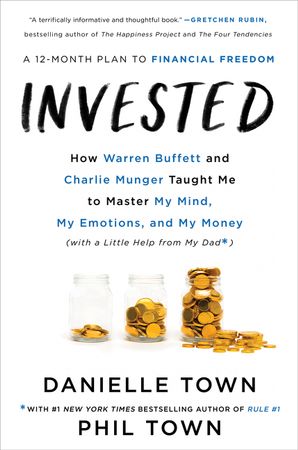
Invested by Danielle Town and Phil Town
Rating: 👍
What did I learn?
- Most retirement savings calculations don’t account for 2-3% inflation over time, which at a 6% market-index return means you likely need to save a lot more than you think. This is something I need to confirm with my own financial projecting, however it makes sense as I didn’t account for inflation (foolishly).
- The Efficient Market Hypothesis is not an absolute truth – there are enough examples of successful investors to disprove this theory
- Leveraging smart investor behaviour (learned from previous books I have read) and finding specific undervalued companies can help you earn above average returns
- Criteria for finding good potential companies:
- You understand the industry
- The company has a durable competitive advantage (moat)
- The company’s values and mission aligns with your personal values
- Available for a good price – often after a large market downturn or specific event that causes investors to panic
- You should create a wishlist of companies that you will purchase when something affects the market to create a good price
- Note: Even though they are a good company, you still need to wait for a good price
- There are quantitative measures such as the growth rates of income, book value, operating cash flow that can indicate a solid moat
- It’s important to make sure the market itself isn’t trading too high, using a market wide measures such as Schiller’s P/E and Buffet’s Market Indicator
- You potentially only need about 10 companies to invest in for a life time. To quote Charlie Munger: “When Warren lectures at business schools, he says, “I could improve your ultimate financial welfare by giving you a ticket with only 20 slots in it so that you had 20 punches—representing all the investments that you got to make in a lifetime. And once you’d punched through the card, you couldn’t make any more investments at all.”
- You should review your holdings quarterly, based on each company’s quarterly reports, to make sure nothing dramatic has changed
- If your holdings become overvalued, sell it to lock in your return and then wait for another sale
- Each time you get paid a dividend or stock buyback, that helps pay down how much capital you’ve put into a share, ideally paying back your principal within 10 years so you are “playing with house money”
- When buying shares, split your purchase into 4 tranches, ex: 25% each tranche, to dollar-cost average when the price falls significantly (spread out over a short period, in case the price continues to fall)
- How often should you invest?
- Based on Millennial Money, you should try to do it 2-4x a year in lump sums, once you have saved enough to ensure the trading fees don’t eat up your principal
- There is no real timing listed in this book, you should feel comfortable sitting in cash and waiting for opportunities to go all in.
- Cash is something that I have recently begun referring to as “opportunity insurance” – I’m not sure where I first heard this.
- Investment funds have to file changes to their holdings every quarter (meaning they will be delayed up to 90 day), but this can provide good insight into what other experts are doing
- Price is calculated in a variety of ways, and it’s up to your (the investor’s) discretion to identify a good price
What can I implement?
-
Do sensitivity testing on my own financial planning for various rates of inflation using a tool like Personal Capital’s Retirement Planner (note: they account for inflation but are fairly bullish using >9% average market returns)
-
Seek ways to get higher returns on investment as a backup to straight index funds such as individual investing, and investing in myself
-
Start to research and prepare for my own investing – I have created my wishlist and begun reviewing annual reports and financials
